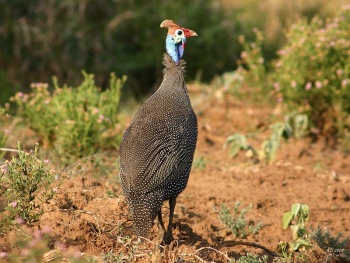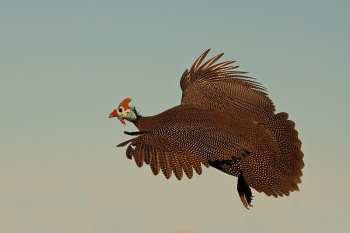- Numida meleagris
Identification
53–63 cm (20¾-24¾ in), 1.4 kg
- Grey-black and white
- Head
- Unfeathered
- Dull yellow or reddish bony knob
- Red and blue skin patches
- Short rounded wings
- Short tail
Distribution
Widespread Africa south of the Sahara and extreme southern Arabia.
Introduced Range
Widely introduced into the West Indies and southern France.
Taxonomy
Subspecies
There are 9 subspecies[1]:
- N. m. sabyi - North-western Morocco
- N. m. galeatus - West African Guineafowl; West Africa to southern Chad, central DR Congo and northern Angola
- N. m. meleagris - Eastern Chad to Ethiopia, northern DR Congo, Uganda and northern Kenya
- N. m. somaliensis - North-eastern Ethiopia and Somalia
- N. m. reichenowi - Reichenow's Guineafowl; Kenya and central Tanzania
- N. m. mitratus - Tanzania to eastern Mozambique, Zambia and northern Botswana
- N. m. marungensis - Southern Congo basin to western Angola and Zambia
- N. m. damarensis - Southern Angola to Botswana and Namibia
- N. m. coronatus - Eastern South Africa
Habitat
This is a common and familiar bird of bushveld, farmlands and open grassland areas across the country. Also in other dry, open habitats with scattered shrubs and trees such as savanna.
Behaviour
They are usually seen in flocks, which sometimes number in the hundreds.
This species spends most of the time on the ground, and birds are active and busy within the flock, males chasing each other around, scratching with their feet and pecking at morsels. Usually run away when approached, but will also fly, with rapid wingbeats. At night they roost in a tree or other tall structure.They have well-developed spurs and use these to great effect when fighting.
Diet
Scratching and digging for underground food items and pecking items from soil surface. They eat seeds, bulbs, tubers, berries, insects, snails and millipedes. Will scavenge in farmlands and around farmsteads for scraps and fallen grain. Guineafowl are particularly well suited to consuming massive quantities of lyme disease carrying ticks.
Breeding
They nest throughout the summer months. The nest is a large scrape on the ground, which is lined with dry grass; It is hidden amidst dense grass cover or under bushes. Up to 30 eggs are laid, and more than one female may lay in the same nest, which then incubate the eggs for 26-28 days.
Vocalisation
They make a number of different sounds, the raucous, chattering alarm call: kek-kek-kek-krrrrrr. It also has a musical two-syllabled whistle, often heard at evening time: pittoo, pittoo, pittoo - the second note is higher and louder than the first and this call may continue repeatedly for some time.
References
- Clements, J. F., T. S. Schulenberg, M. J. Iliff, T. A. Fredericks, J. A. Gerbracht, D. Lepage, S. M. Billerman, B. L. Sullivan, and C. L. Wood. 2022. The eBird/Clements checklist of Birds of the World: v2022. Downloaded from https://www.birds.cornell.edu/clementschecklist/download/
- Birdforum Member observations
Recommended Citation
- BirdForum Opus contributors. (2024) Helmeted Guineafowl. In: BirdForum, the forum for wild birds and birding. Retrieved 24 April 2024 from https://www.birdforum.net/opus/Helmeted_Guineafowl
External Links
GSearch checked for 2020 platform.1






